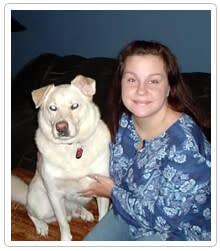
Eons ago, when I was still a naive teenager with her first young dog, I had a lot to learn about dog proofing. Luckily for you, Lyger, my now 13 year old Shepherd mix has given me quite an education in canine criminology over the years. I’m here to share my wealth of experience so that your prized possessions might fare a bit better.
How naive was I back then, you wonder? So naive that I thought that a dog with a propensity for chewing should be confined to my bedroom when I went out. My bedroom… where my mattress was. That naiveté died when I found him chewing a hole to China, via my mattress and box spring. He had chewed a hole, right in the middle of my spot, so big that his entire head was stuck.
Crate Training
Anything your dog’s mouth can reach is fair game for chewing, so it’s up to you to keep him honest. The first, most effective step: crate training. While crate training typically starts with puppies, most adult dogs take to it fairly well. The key points: make sure the crate is large enough to give your dog room to stand, turn around and stretch, but not so large that he can soil the kennel and scoot away from it.
Home Alone
There is the occasional dog who does not tolerate crating or confinement and tends to be more destructive to both himself and his small area. Lyger is one of them. These dogs need to be given a safe space to roam, within reason. You should close doors to rooms that are nonessential to your dog’s adventures. Baby gates allow for different configurations, but some dogs chew these too.
If your dog will be left unsupervised around the house, there are deterrents, such as bitter apple spray, to prevent your dog from chewing upholstery, furniture or laundry. In my college days, my dirty laundry often got a spritz because there’s nothing a dog with separation anxiety likes better than chewing up your favorite bra.
Prevention: Only you can take a bite out of crime
I will never forget the time I was headed out for the evening but stopped back home to find Lyger had jumped up on the stove to get at an empty carry-out container and started one of the burners! Had I not stopped back home there could have been a terrible outcome. We’ve kept the knobs off our stove since then.
Think ahead as to the ways your dog could get into trouble, and remember the old adage about an "ounce of prevention." Using baby-safety devices around your home to lock down trash cans, toilets and cleaning products might save your dog from injury and prevent you from costly vet bills or home renovations.
You have no one to blame...
If I get lazy and don’t take the trash out, instead sitting an empty tuna can on top of the heap, it’s going to get chewed up. It’s probably also going to lead to coffee grounds and paper towels being spread around my kitchen. Then there’s going to be the messy business in the back yard. And who do I have to blame? Myself. If your dog got into something, it is because you let him.
It’s not just about keeping your dog out of trouble. It’s about reducing his need for mayhem. Keep your dog well-exercised to release any pent up energy that might otherwise be taken out on your table leg. Offer him enrichment toys and mental stimulation, so he’s got positive outlets while you’re occupied. If you can keep your dog mentally balanced, while using a bit of pro-active common sense, you won’t have to wait 13 years for your dog to be a model stay-at-home canine.
Too bad I can’t go back in time and tell myself all of this.